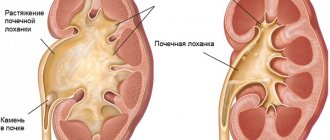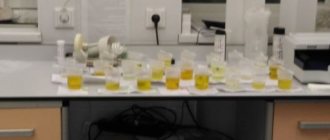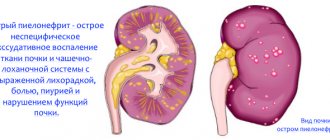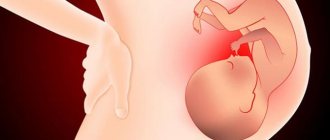Among the many bacteria, there are real werewolves that can transform from useful to pathogenic. These include Klebsiella pneumonia - a bacillus that lives on the mucous membranes of the larynx, trachea and even in the bronchi. Causing seemingly common diseases of the bronchopulmonary system, K. pneumoniae can provoke irreversible changes, including those leading to death.
Klebsiella poses a particular danger to humans; if left untreated, it can have serious consequences.
Reasons for the development of the disease
The source of the spread of the disease is an infected person. Having penetrated the body, Klebsiella can remain dormant and not manifest itself in any way. However, there are factors that can cause the growth and reproduction of bacteria and the development of infection.
- Decreased immune system caused by many reasons,
- Failure to comply with personal hygiene rules,
- Frequent colds,
- Taking antibiotics for a long time,
- Bad habits,
- The presence of systemic pathologies.
When Klebsiella multiplies and inflammatory processes occur, the lungs, urinary system, and intestines are most often affected.
When does a bacterium become pathogenic?
Already on the fifth or sixth day of human life, Klebsiella pneumoniae settles in the microflora of the digestive organs and oral cavity. The norm for bacteria content is in children up to 10 to 5 degrees; in adults, the permissible value is usually lower. If the throat smear or stool test reaches klebsiella pneumoniae 10 to 6 degrees or more, then the microorganism is considered pathogenic.
Various factors can provoke such active proliferation of bacteria:
- Reduced immunity (especially typical for newborns and the elderly).
- Diabetes.
- Avitaminosis.
- Systematic intake of alcohol.
- Dystrophy.
- Conditions after organ transplantation.
- Disruption of normal microflora as a result of taking antibiotics to which Klebsiella is insensitive.
An increase in the number of pathogens is accompanied by an abundant release of toxic substances, which cause inflammation.
The main route of transmission of bacteria is airborne droplets. But Klebsiella pneumoniae lives in the soil for a long time, so we cannot exclude the possibility of it entering the body from dirty hands and poorly processed food.
The development of diseases can be associated both with the growth of one’s own pathogenic microflora, and with the penetration of new bacteria from the outside.
The microorganism can mutate and become the cause of nosocomial infection. Treating the disease in this form is much more difficult because these bacteria are often not susceptible to common antibiotics.
Symptoms
When klebsiella pneumoniae enters the body, the respiratory system is affected. Inflammatory processes occurring in the lungs can consume entire lobes.
The onset of the disease when the upper respiratory tract is infected by bacteria is manifested by the following symptoms:
- a sharp manifestation of weakness,
- headaches,
- feverish state with chills,
- redness of the throat,
- pain in the side when sighing,
- attacks of dry cough with the discharge of sputum of an unpleasant odor, sometimes mixed with blood.
If the following symptoms appear, you should immediately consult a urologist:
- painful urination,
- frequent urge to urinate,
- pressing sensation in the bladder area,
- urine is released in small portions,
- presence of blood in the urine.
Such symptoms indicate the presence of bacteria in the urine and the development of an infection of the excretory tract.
When the intestines are damaged, the following symptoms of the disease occur:
- pain in the stomach area,
- loss of appetite,
- periodic bouts of vomiting and heartburn,
- loose stools, sometimes mixed with green mucus or bloody discharge,
- elevated body temperature.
Features of therapy
Klebsiella in the urine, the treatment of which must be timely and comprehensive, requires the appointment of etiotropic, pathogenetic and syndromic therapy. Mild manifestations of the disease allow outpatient treatment, but in other cases hospitalization in an inpatient infectious diseases department is necessary.
For outpatient therapy use:
- Probiotics are drugs that restore normal microflora. Representatives: “Bifiform”, “Lactobacterin”, “Bifikol”, “Linex”. Take for 10-14 days.
- Bacteriophages can be used from birth. The dosage is selected by the doctor depending on the age of the patient.
The principle of this treatment regimen is also used if Klebsiella is detected in the urine during pregnancy.
Children under adolescence and people with severe forms of the disease require mandatory hospitalization. In such cases, antibacterial agents are prescribed with mandatory determination of the sensitivity of pathogens to drugs. Depending on age, the following groups of antibiotics are selected:
- penicillins - “Ampicillin”, “Ampioks”;
- aminoglycosides - “Streptomycin”, “Monomycin”;
- cephalosporins - Cefotaxime, Ceftriaxone;
- tetracyclines - “Tetraolean”, “Tetracycline”;
- fluoroquinolones - “Ciprofloxacin”, “Ofloxacin”.
Pathogenetic therapy requires the use of antipyretic, detoxifying drugs, as well as rehydration agents. A specialist can prescribe antiemetic and expectorant medications and herbal remedies. A vaccine has not been developed to prevent Klebsiella infection. Preventive measures include hygienic education of children, strengthening the immune system and timely treatment of chronic foci of infection in the body.
Diagnostics
During the examination, a qualified doctor will be able to recognize wheezing in the lungs and the appearance of hemorrhages on the mucous membranes of the patient. In addition, additional diagnostic examination is required:
- laboratory tests of urine and blood, in which an increased content of white blood cells and anemia will be observed.
- X-ray – in case of pathology, confirms the presence of a dark spot in the lungs.
- If your stool changes, you will need to take a stool test.
The most important indicator of the presence of Klebsiella bacteria in the body is the results of a urine test. The norm is the complete absence of such bacteria. Detection of the presence of Klebsiella in a person during diagnosis is an indicator that this microorganism multiplies and provokes the development of the disease in different organs:
- Changes occur in the intestines. In this case, a stool examination will be needed.
- Damage to the excretory tract. In such cases, the doctor is based on the patient’s complaints, since such diseases have severe symptoms.
- The upper sections of the respiratory tract are affected, as well as the mucous membranes of the nasal passages. In this case, an x-ray and additional tests will be needed to accurately determine the diagnosis.
klebsiella pneumoniae. Is she being treated?
For print. Best regards, Galina Ivanova. Should we celebrate Halloween? Need Advertising? Comments on news on this page reflect solely the opinions of the authors or users who posted them. The site administration reserves the right to delete or correct comments at its own discretion.
The article presents data from a retrospective study of histories of premature births and their perinatal outcomes. A statistical analysis of the influence of nonspecific cervicovaginal infections on perinatal outcomes was carried out.
Search on the site.
Anatomy and physiology of the gastrointestinal tract. Diseases of the digestive system KK93 and others. Obesity, weight loss. Medicines. Non-medicinal products. From the history of gastroenterology and medicine in general. The information presented in this section about medications, diagnostic and treatment methods is intended for medical professionals and does not constitute instructions for use. VIDEO ON THE TOPIC: Gardnerella in men. Clinical case No. 30
Treatment course
The presence of Klebsiella proliferation in the body requires immediate treatment. How to treat and the duration of the treatment course should only be prescribed by the attending physician. First of all, it is necessary to identify the causative agent of the disease and eliminate the cause. The course of treatment and medications are selected only by the attending physician individually. The medicine is selected based on the test results, which acts on a specific type of bacteria.
Treatment includes:
- Use of antibiotics. The correct selection of antibacterial therapy is required, since Klebsiella is resistant to many groups of antibiotics.
- Use of folk remedies.
- In some cases, physiotherapy and massage.
In case of a large accumulation of parasites in the intestines, a therapeutic course of taking bacteriophages intended for a specific type of bacteria is prescribed.
A full course of treatment is required. In case of prolonged high fever and the development of pneumonia, hospitalization and strict bed rest are often required. First of all, treatment will be aimed at reducing intoxication of the body and after recovery, as a rule, they will be sent to a hospital under the constant supervision of a doctor, since complications often develop.
Treatment
If the concentration of the microbe is high, treatment is necessary.
Antibiotics and bacteriophages
If the pathogen is determined to be 10 x 5 and 10 x 6 or higher, then antibiotic therapy is mandatory.
A drug sensitivity test is first performed. Klebsiella has the ability to develop resistance to many agents. It forms substances that neutralize antibiotics.
More often, treatment begins with the use of broad-spectrum drugs, then based on sensitivity.
Specific bacteriophages are used.
Rinsing
If Klebsiella is present in the pharynx or other parts of the respiratory tract and oral cavity, treatment with disinfectants is mandatory. In this case, the microbe is removed purely mechanically. The mucous membrane is cleansed. Furacilin, hexoral, miramistin, decoctions of calendula and chamomile are used.
Klebsiella and pregnancy
There are cases when Klebsiella is detected during pregnancy. The presence of such an infection during this pregnancy is not at all desirable, since it can negatively affect the development of the fetus. First of all, you should re-take your urine for analysis and make sure that there is an increased content of bacteria in it. If Klebsiella pneumoniae is detected in the urine of a pregnant woman, immediate treatment is required, as this is a serious problem that can seriously threaten the health of the mother and child.
What it is?
Klebsiella pneumoniae is a gram-negative bacterium that can be part of the normal microflora of the respiratory organs, intestines, and skin. When viewed under a microscope, it looks like a stick with rounded edges. The bacteria are immobile and occur singly, in pairs, and in clusters.
The microorganism was first discovered in a patient with pneumonia, hence the name of the bacterium. However, it can cause inflammation not only of the respiratory system, but also of the gastrointestinal tract and genitourinary system. Klebsiella pneumonia is often detected in a smear from the cervical canal in women - this may be normal.
Diagnostic measures
If a person has symptoms of Klebsiella, the doctor will refer him for examination. First, a history will be taken, followed by laboratory tests. Such an examination will help detect the opportunistic microorganisms in question in feces, sputum, urine, oral cavity, cerebrospinal fluid, and bile. What specific biological material will be chosen for research depends on the existing symptoms, since they will make it clear where Klebsiella is most likely located.
Research methods used for diagnosis:
- sowing material on nutrient media;
- bacterioscopy (Gram staining);
- serological methods;
- coprogram.
Possible complications
If the infection is severe and pneumonia or sepsis is diagnosed, the following complications may develop:
- hemorrhagic syndrome;
- infectious-toxic shock;
- cerebral edema;
- pulmonary edema.
After suffering from Klebsiella, the immune system is very weakened, so a relapse of the disease may well occur.
The opportunistic microorganism in question is quite insidious, and every effort must be made to avoid the development of infection. And to do this, it is enough to follow the rules of personal hygiene, eat only washed vegetables and fruits.
Tsygankova Yana Aleksandrovna, medical observer, therapist of the highest qualification category
31, total, today
( 204 votes, average: 4.57 out of 5)
HPV vaccine
Intestinal infections in adults: symptoms and treatment











